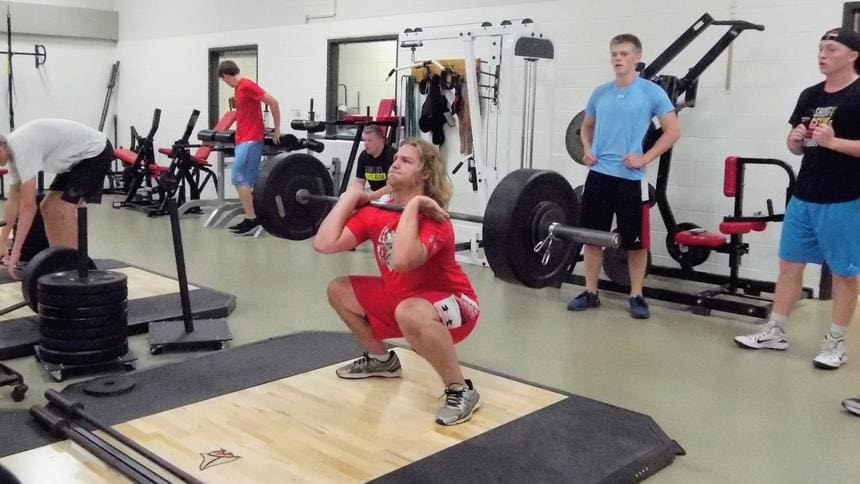Article reposted with permission from Robert Williams of the Detroit Lakes Tribune. View the Original Here.
Detroit Lakes middle school and high school athletes are putting aside what could be a leisurely summer to become more explosive athletically as part of the Laker Speed and Strength program sponsored by the Laker Sports Boosters.
While kids could be out on the pontoon and having fun, instead, they are concentrating on getting stronger and quicker to prepare for the upcoming school year.
 In-season, workouts are matched with the type of skills worked on in practice.
“In track, the workouts match what we do on the track that day,” said Labine. “If I’m doing a speed workout we’re going to come in here and work on speed lifts. Same with slow-recovery workouts and lifts.”
A typical summer workout begins with a dynamic warm up with a speed and agility component and sprinting before athletes get into lifting. Lifting begins with total body and power movements early on before working into strength exercises.
The staff also incorporates new technology to their own benefit as well as the student-athletes.
Thanks to a donation from the Laker Sports Boosters, coaches and kids have streamlined workouts using a software program called PLT4M (Platform) that tracks workouts, allows coaches to plan and design workouts and provides video instruction on proper lifting techniques.
Each athlete has a profile and via their phones have workout plans ready to go that were created by the coaches.
“Strength conditioning is changing,” said Mike Labine. “You can’t just do the same exercises over and over. You plateau. We’re trying to train our kids to be speed, power and explosive athletes.”
PLT4M has helped formulate that process and has sped up the manner of doing so.
The software includes a team leaderboard and a national leaderboard which creates a friendly competition for the athletes. On the admin side, coaches can run reports that are team-specific, which includes attendance, scheduling, and access to their individual workouts.
The software will also transition to the school year for Omang’s weightlifting classes that are part of the curriculum, not just for kids involved in sports.
Omang praised the level of commitment from the school board to the booster club in allowing Speed and Strength to be a progressive opportunity for kids.
“It helps all the programs, not just football,” he said. “The one thing I like about what we have going here, when I was a strength coach in the cities, we didn’t have the buy-in or the resources like we have here.”
In-season, workouts are matched with the type of skills worked on in practice.
“In track, the workouts match what we do on the track that day,” said Labine. “If I’m doing a speed workout we’re going to come in here and work on speed lifts. Same with slow-recovery workouts and lifts.”
A typical summer workout begins with a dynamic warm up with a speed and agility component and sprinting before athletes get into lifting. Lifting begins with total body and power movements early on before working into strength exercises.
The staff also incorporates new technology to their own benefit as well as the student-athletes.
Thanks to a donation from the Laker Sports Boosters, coaches and kids have streamlined workouts using a software program called PLT4M (Platform) that tracks workouts, allows coaches to plan and design workouts and provides video instruction on proper lifting techniques.
Each athlete has a profile and via their phones have workout plans ready to go that were created by the coaches.
“Strength conditioning is changing,” said Mike Labine. “You can’t just do the same exercises over and over. You plateau. We’re trying to train our kids to be speed, power and explosive athletes.”
PLT4M has helped formulate that process and has sped up the manner of doing so.
The software includes a team leaderboard and a national leaderboard which creates a friendly competition for the athletes. On the admin side, coaches can run reports that are team-specific, which includes attendance, scheduling, and access to their individual workouts.
The software will also transition to the school year for Omang’s weightlifting classes that are part of the curriculum, not just for kids involved in sports.
Omang praised the level of commitment from the school board to the booster club in allowing Speed and Strength to be a progressive opportunity for kids.
“It helps all the programs, not just football,” he said. “The one thing I like about what we have going here, when I was a strength coach in the cities, we didn’t have the buy-in or the resources like we have here.” 





